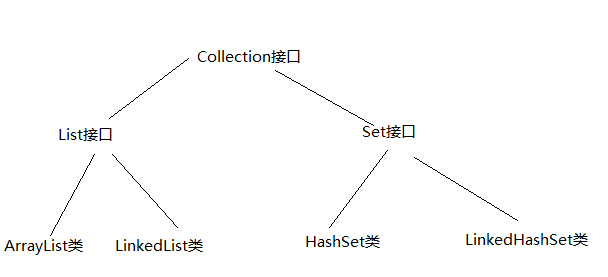1、集合使用的回顾
(1)ArrayList集合存储5个int类型元素
1 public static void main(String[] args) { 2 ArrayList<Integer> list = new ArrayList<Integer>(); 3 list.add(111); 4 list.add(222); 5 list.add(333); 6 list.add(444); 7 list.add(555); 8 for (int i = 0; i < list.size(); i++) { 9 System.out.println(list.get(i)); 10 } 11 }
(2)ArrayList集合存储5个Person类型元素
1 public static void main(String[] args) { 2 ArrayList<Person> list = new ArrayList<Person>(); 3 list.add(new Person(“小强”)); 4 list.add(new Person(“老王”)); 5 list.add(new Person(“小虎”)); 6 list.add(new Person(“小泽”)); 7 list.add(new Person(“小红”)); 8 for(int i=0; i<list.size(); i++){ 9 Person p = list.get(i); 10 System.out.println(p); 11 } 12 }
(3)集合,集合是java中提供的一种容器,可以用来存储多个数据。
(4)数据多了,可以使用数组存放或者使用ArrayList集合进行存放数据。那么,集合和数组既然都是容器,它们有啥区别呢?
数组的长度是固定的。集合的长度是可变的。
(5)集合中存储的元素必须是引用类型数据。
2、集合继承关系图
(1)ArrayList的继承关系
查看ArrayList类发现它继承了抽象类AbstractList同时实现接口List,而List接口又继承了Collection接口。Collection接
interface List extends Collection {}
public class ArrayList extends AbstractList implements List{}
(2)集合继承体系
我们在使用ArrayList类时,该类已经把所有抽象方法进行了重写。那么,实现Collection接口的所有子类都会进行方法重写;
Collecton接口常用的子接口有:List接口、Set接口;
List接口常用的子类有:ArrayList类、LinkedList类;
Set接口常用的子类有:HashSet类、LinkedHashSet类;

3、集合Collection的方法
1 /* 2 * Collection接口中的方法 3 * 是集合中所有实现类必须拥有的方法 4 * 使用Collection接口的实现类,程序的演示 5 * ArrayList implements List 6 * List extends Collection 7 * 方法的执行,都是实现的重写 8 */ 9 public class CollectionDemo { 10 public static void main(String[] args) { 11 function_2(); 12 } 13 14 15 /* Collection接口方法 16 * Object[] toArray() 集合中的元素,转成一个数组中的元素, 集合转成数组 17 * 返回是一个存储对象的数组, 数组存储的数据类型是Object 18 */ 19 private static void function_2() { 20 Collection<String> coll = new ArrayList<String>(); 21 coll.add("abc"); 22 coll.add("i"); 23 coll.add("love"); 24 coll.add("Java"); 25 coll.add("123"); 26 27 Object[] objs = coll.toArray(); 28 for(int i = 0 ; i < objs.length ; i++){ 29 System.out.println(objs[i]); 30 } 31 } 32 /* 33 * 学习Java中三种长度表现形式 34 * 数组.length 属性 返回值 int 35 * 字符串.length() 方法,返回值int 36 * 集合.size()方法, 返回值int 37 */ 38 39 /* 40 * Collection接口方法 41 * boolean contains(Object o) 判断对象是否存在于集合中,对象存在返回true 42 * 方法参数是Object类型 43 */ 44 private static void function_1() { 45 Collection<String> coll = new ArrayList<String>(); 46 coll.add("abc"); 47 coll.add("i"); 48 coll.add("love"); 49 coll.add("Java"); 50 coll.add("123"); 51 52 boolean b = coll.contains("Java"); 53 System.out.println(b); 54 } 55 56 57 /* 58 * Collection接口的方法 59 * void clear() 清空集合中的所有元素 60 * 集合容器本身依然存在 61 */ 62 public static void function(){ 63 //接口多态的方式调用 64 Collection<String> coll = new ArrayList<String>(); 65 coll.add("abc"); 66 coll.add("bcd"); 67 System.out.println(coll); 68 69 coll.clear(); 70 71 System.out.println(coll); 72 73 } 74 }
4、集合Collection的remove方法
1 /* 2 * Collection接口方法 3 * boolean remove(Object o)移除集合中指定的元素 4 */ 5 private static void function_3(){ 6 Collection<String> coll = new ArrayList<String>(); 7 coll.add("abc"); 8 coll.add("money"); 9 coll.add("love"); 10 coll.add("Java"); 11 coll.add("money"); 12 coll.add("123"); 13 System.out.println(coll); 14 15 boolean b = coll.remove("money"); 16 System.out.println(b); 17 System.out.println(coll); 18 }